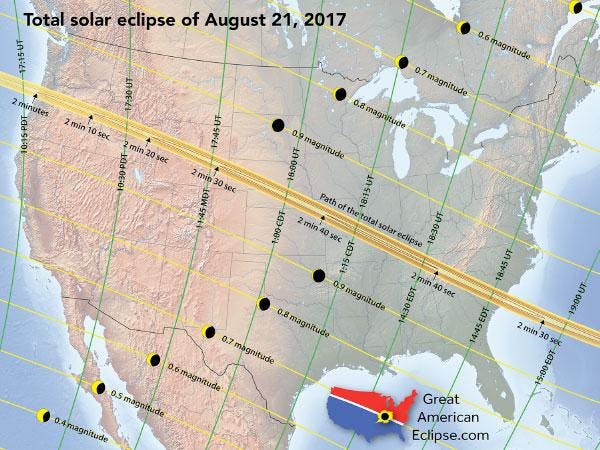
Any planet that has at least one moon is potentially subject to experiencing eclipses. What form these eclipses take depends on the size(s) and the orbit(s) of the moon(s).

We have not seen any eclipses in the Star Trek Universe, though we do know they occur on worlds other than Earth. In the Voyager episode “Ex Post Facto,” Lidell Ren talks about an eclipse that she and her husband Professor Tolen Ren witnessed on his home planet Banea back in 2367. Banea has one moon, so in that sense the conditions are similar to ours here on Earth.
Here on Earth we experience two basic types of eclipses, lunar and solar. During both, the Earth and the Moon have to be exactly aligned with the Sun, so that the shadow of one body can hit the other. Our Moon orbits Earth inclined by about 5 degrees, which is why we don’t get eclipses regularly every month. Only when the line of intersection of the orbital planes of the Moon and the Earth (line of nodes) is directly aligned with the Sun can the shadows hit.
When the Earth’s shadow covers the Moon, we have a lunar eclipse. We actually had one just last night. If the Moon goes exactly through Earth shadow, it is a total lunar eclipse. As the Earth is much bigger than the Moon, the Moon can be covered entirely by Earth’s shadow, so everyone on the night side of Earth can see the eclipse.
When the Moon’s shadow hits the Earth, we have a solar eclipse. Since the Moon is much smaller than the Earth, its shadow is much smaller, and it only hits a small area on the Earth. But since Earth rotates around its axis, that spot marches across Earth’s surface. It so happens that the sizes and distances of Moon and Sun from Earth are such that the Moon can cover the Sun exactly. This is what we call a total solar eclipse. And it is a wondrous sight!
And why am I going on about this? As it turns out, this year, specifically on 21 August, the shadow of the Moon will travel across the United States from the Northwest to the Southeast. It has been dubbed the “Great American Solar Eclipse of 2017,” and it is a marvelous opportunity for everyone in the US to experience this unique phenomenon without having to join an expensive expedition. Everyone in the US is within a few hundred miles of the path of totality.

Figure 1: The path of totality across the United States. Source: Michael Zeiler, www.GreatAmericanEclipse.com.

Figure 2: This image shows in a bit more detail the areas the path of totality will traverse. Source: Michael Zeiler, www.GreatAmericanEclipse.com.

Figure 3: Some special places around the US are setting up public viewing spots along the path of totality. Source: Michael Zeiler, www.GreatAmericanEclipse.com.

Figure 4: A total solar eclipse. This is the only time you can see the corona of the Sun. Source: NASA.

Figure 5: The effects of a partial solar eclipse. The sunlight goes though the leaves to show an eclipse “ghost” (reflection). Source: Inge Heyer (Laramie, Wyoming, 20 May 2012).
NASA has made a video showing a simulation of the expected path of totality across the US. It has amazing detail and will help people find a good spot to observe the eclipse. The URL is shown below.
If you plan to travel to be in the path of totality, you might be disappointed to find out that all hotel rooms have been booked for months if not years. But friends managed to find a campground for an RV just the other day. So there are still opportunities to find a place to stay, but you have to act quickly, and you might need to be prepared to rough it.
Find yourself an area where you will be able to observe the Sun without anything in the way. Totality itself will be about 2 minutes and 40 seconds, but the partial concealment of the Sun on either side is also very interesting to watch.
There are many resources for you to inform yourself about this incredible natural phenomenon. The website for the Great American Eclipse is one, and of course NASA also has information available. Both URLs are given below. You can find out when exactly the eclipse will happen at the location you wish to travel to.
Now to the most important aspect of this endeavor: SAFETY! Do not ever look directly at the Sun! You will damage your eyes!
There are many ways to observe the Sun safely. You can make a basic pinhole camera to obtain a projection of the Sun’s image, you can use a mirror to project the Sun’s image onto a screen, you can use eclipse glasses which are available on the web, and you can use specialty filters for your camera (also available on the web and from your better photography specialty stores). Regular sun glasses are not enough! You need the special equipment mentioned here to do this safely.
I hope all of you will take this opportunity to see one of our world’s greatest natural phenomena.
Here are a few links for you if you’d like to know more about this topic.
The Great American Eclipse:https://www.GreatAmericanEclipse.com2017 Eclipse Across American through the Eyes of NASA:http://eclipse2017.nasa.gov/The path of totality across the US (NASA video):https://www.youtube.com/watch?v=MJgXaqW3md8Memory Alpha:http://en.memory-alpha.orgIf you are interested in hearing more about the latest discoveries in the physical sciences and technology in a fannish setting, come visit us at Shore Leave next summer (7-9 July 2017). This fan-run convention features over 12 hours of science programming, in addition of course to all the usual con activities. One of our speakers from NASA will specifically talk about the 2017 Eclipse and how you can prepare yourself. For more information please visit www.shore-leave.com.Inge Heyerwww.ingeheyer.com

